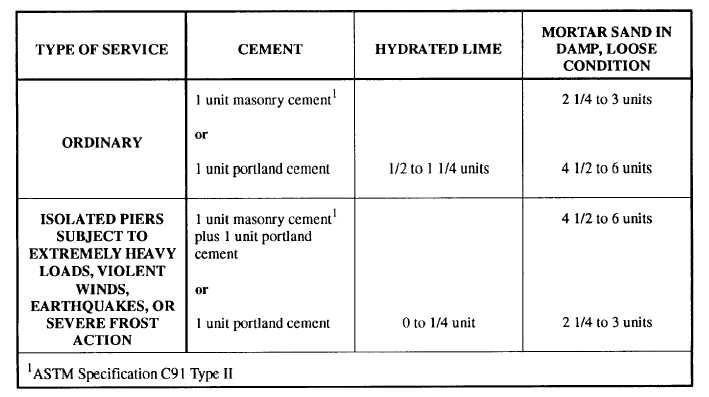using mortar having good water retentivity, using the proper grade of sand, and thorough mixing. You do not obtain good plasticity by using a lot of cementitious materials. Mortar properties depend largely upon the type of sand it contains. Clean, sharp sand produces excellent mortar, but too much sand causes mortar to segregate, drop off the trowel, and weather poorly.
Water Retentivity
Water retentivity is the mortar property that resists rapid loss of water to highly absorbent masonry units. Mortar must have water to develop the bond. If it does not contain enough water, the mortar will have poor plasticity and workability, and the bond will be weak and spotty. Sometimes, you must wet brick to control water absorption before applying mortar, but never wet concrete masonry units.
Mortar Strength and Durability
The type of service that the masonry must give determines the strength and durability requirements of mortar. For example, walls subject to severe stress or weathering must be laid with more durable, stronger mortar than walls for ordinary service. Table 8-1 gives mortar mix proportions that provide adequate mortar strength and durability for the conditions listed.
Types of Mortar
The following mortar types are proportioned on a volume basis:
Type M - One part portland cement, one-fourth part hydrated lime or lime putty, and three parts sand; or, one part portland cement, one part type II masonry cement, and six parts sand. Type M mortar is suitable for general use, but is recommended specifically for below-grade masonry that contacts earth, such as founda- tions, retaining walls, and walks.
Type S - One part portland cement, one-half part hydrated lime or lime putty, and four and one-half parts sand; or, one-half part portland cement, one part type II masonry cement, and four and one-half parts sand. Type S mortar is also suitable for general use, but is recom- mended where high resistance to lateral forces is required.
Table 8-1.-Recommended Mortar Mix Proportions by Unit Volume

